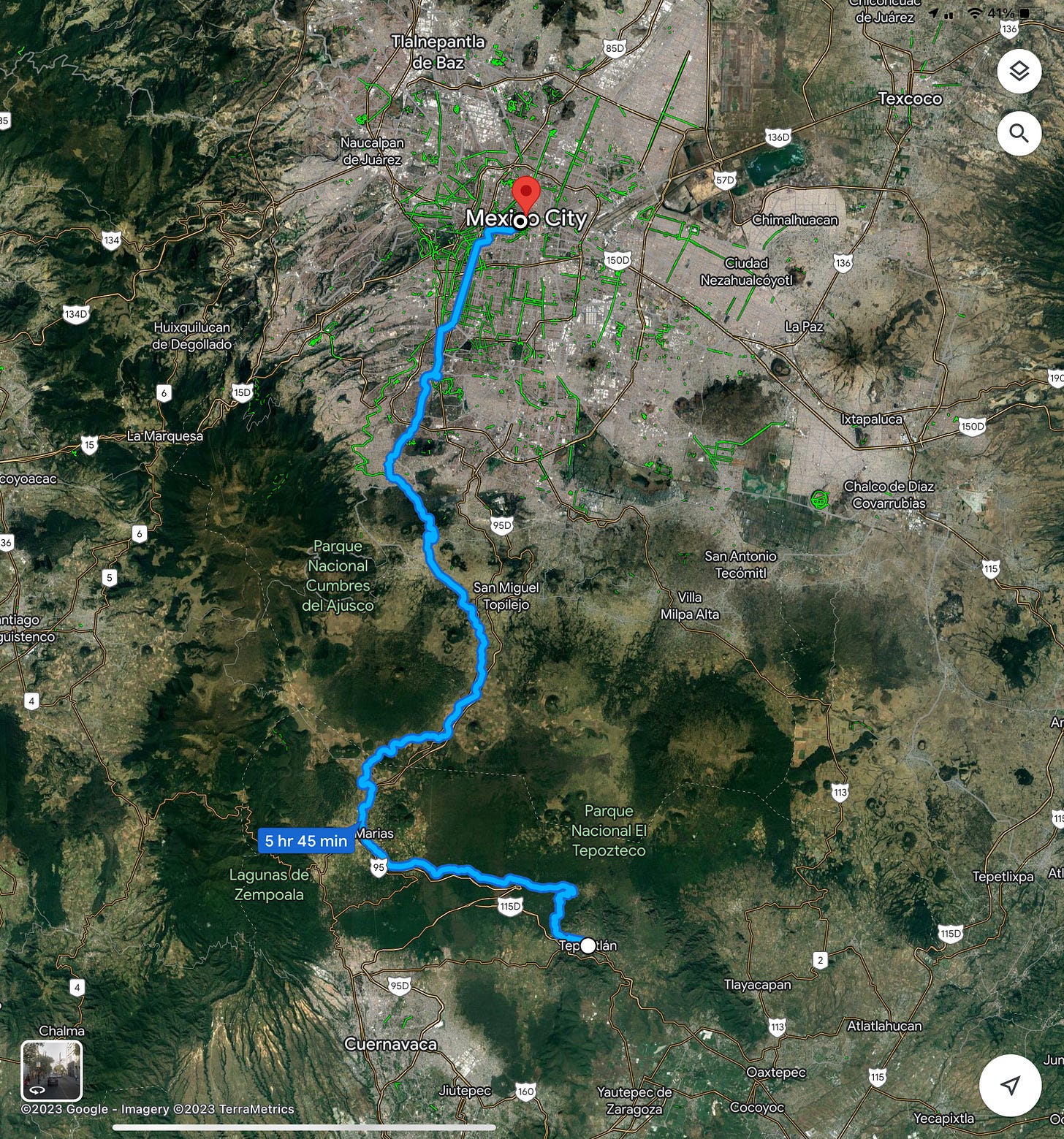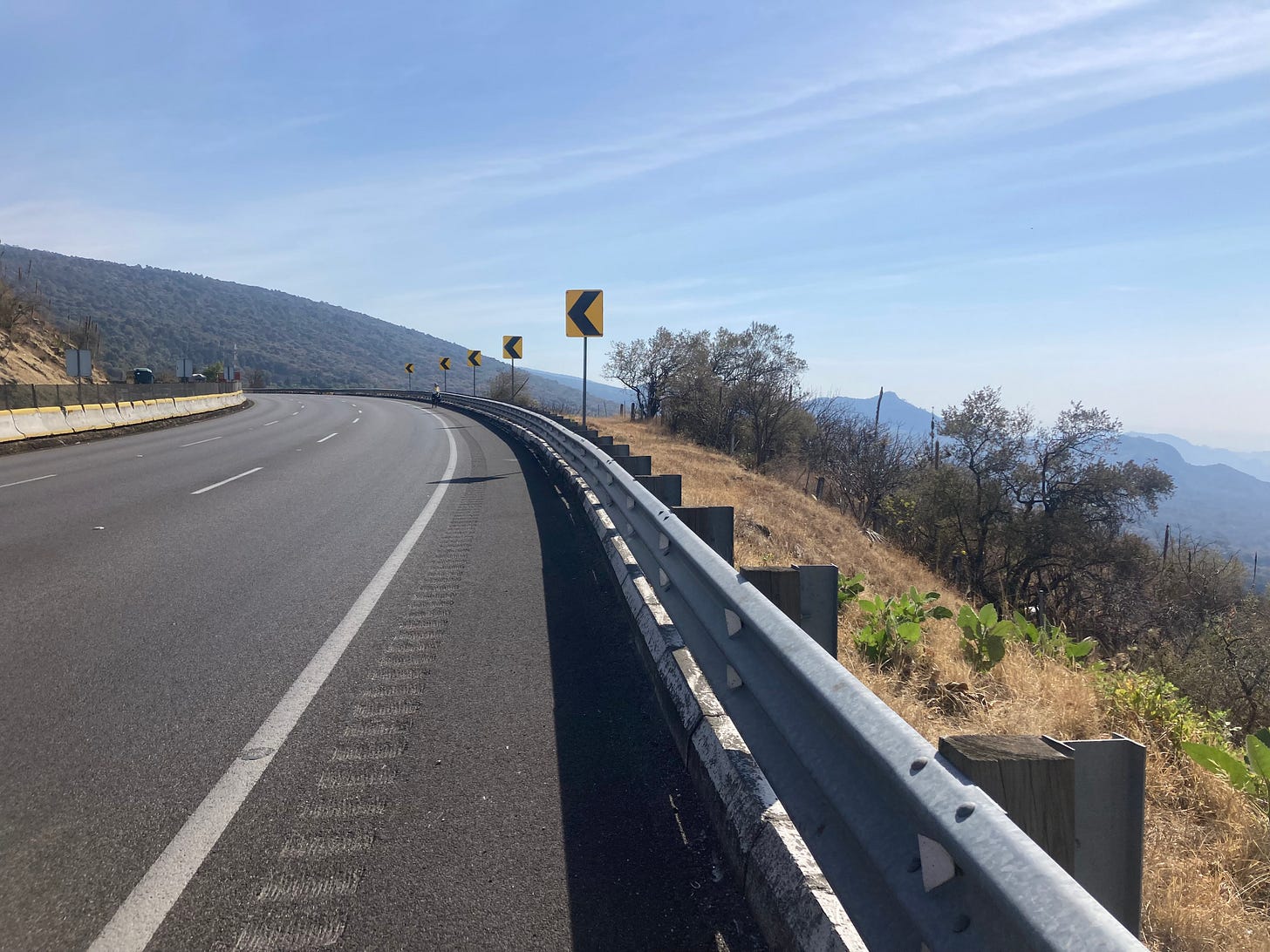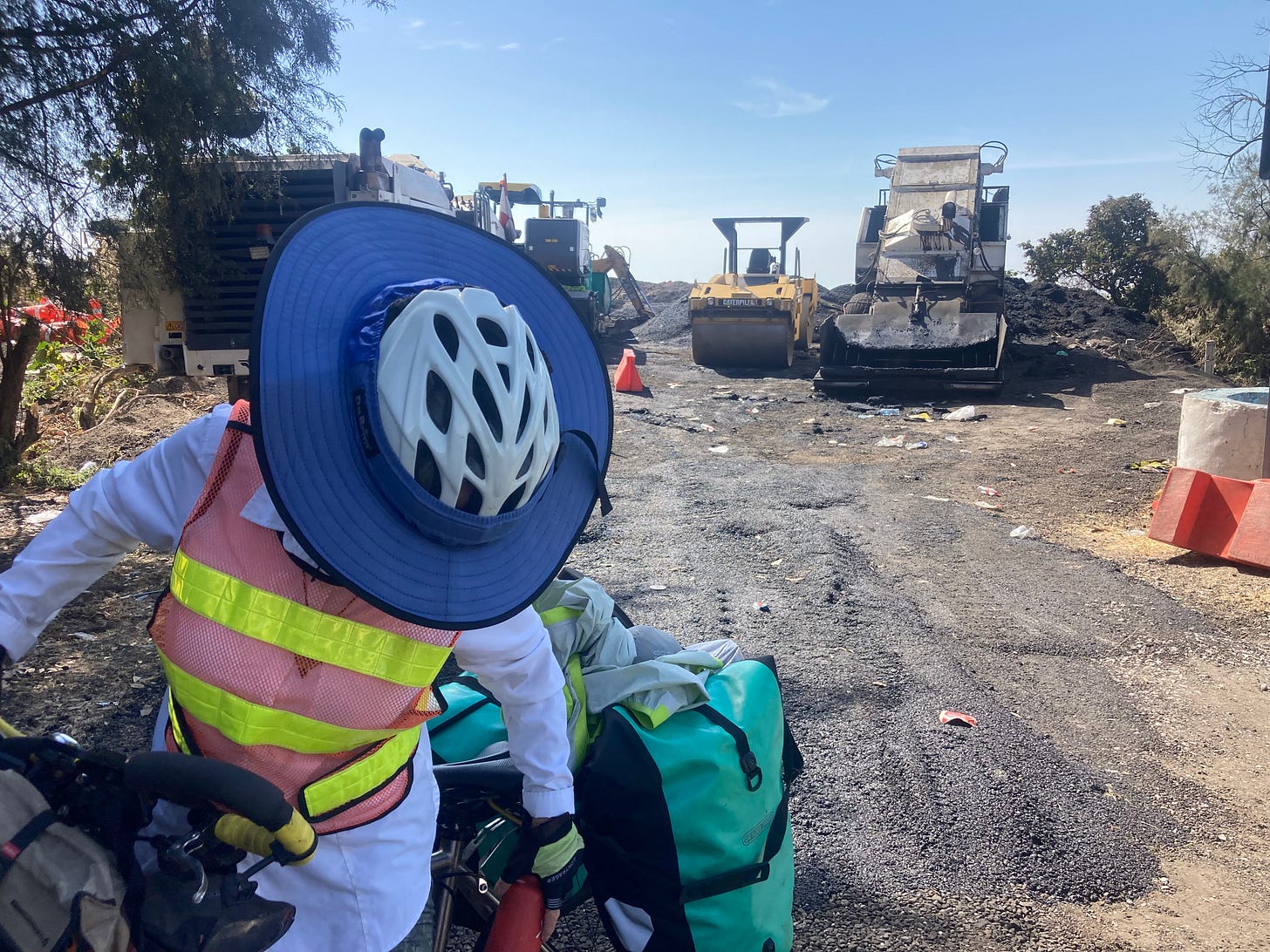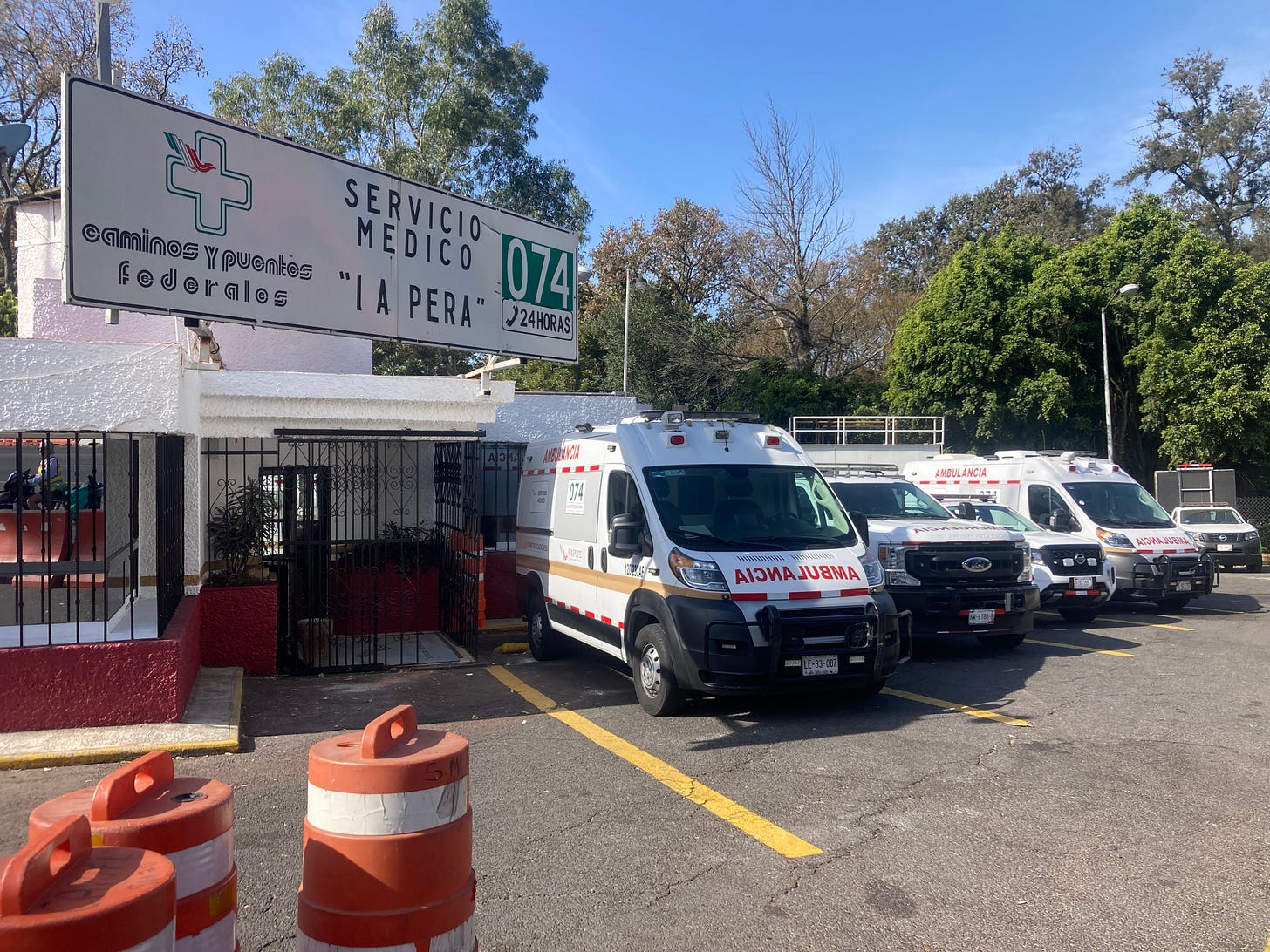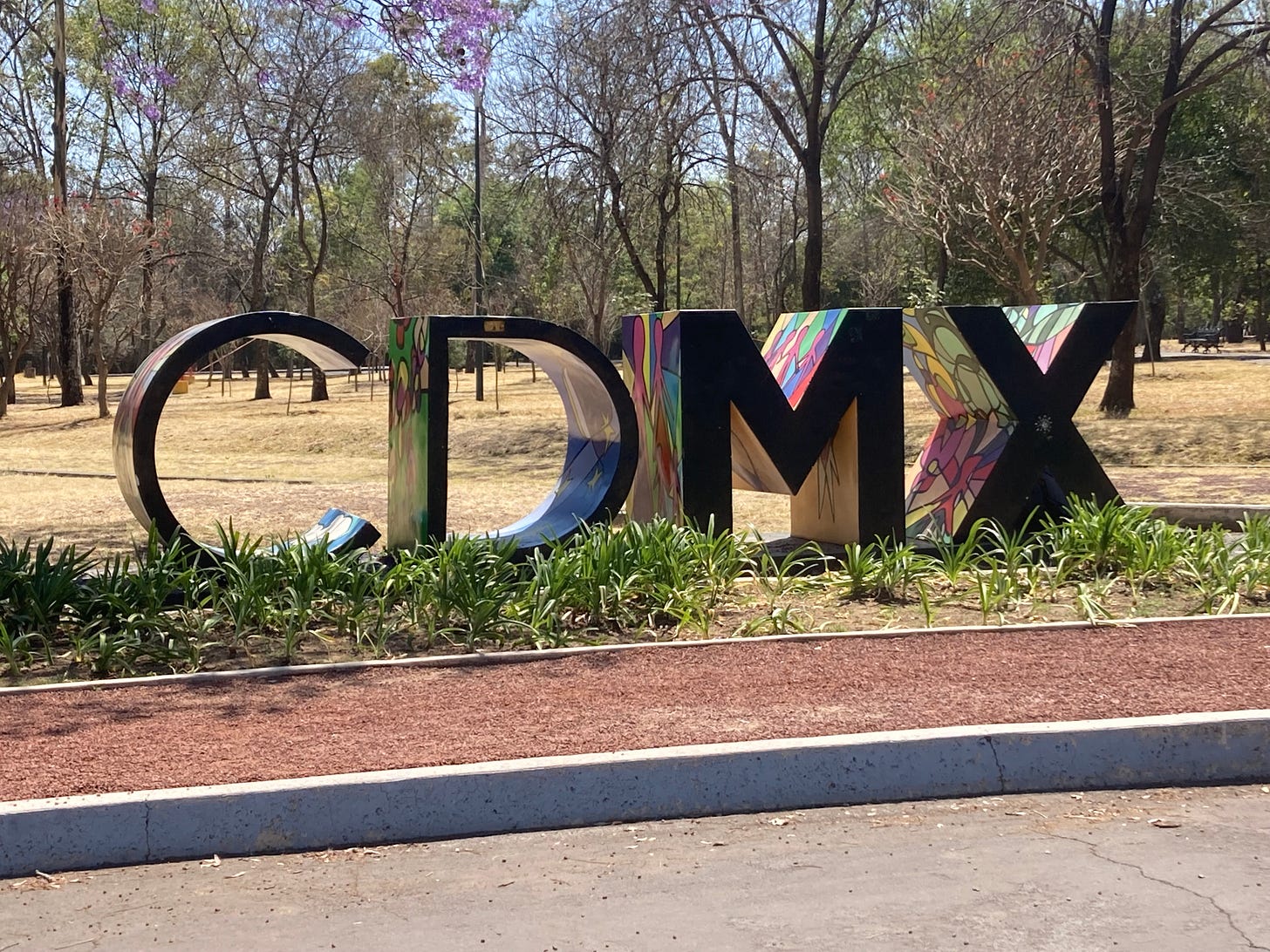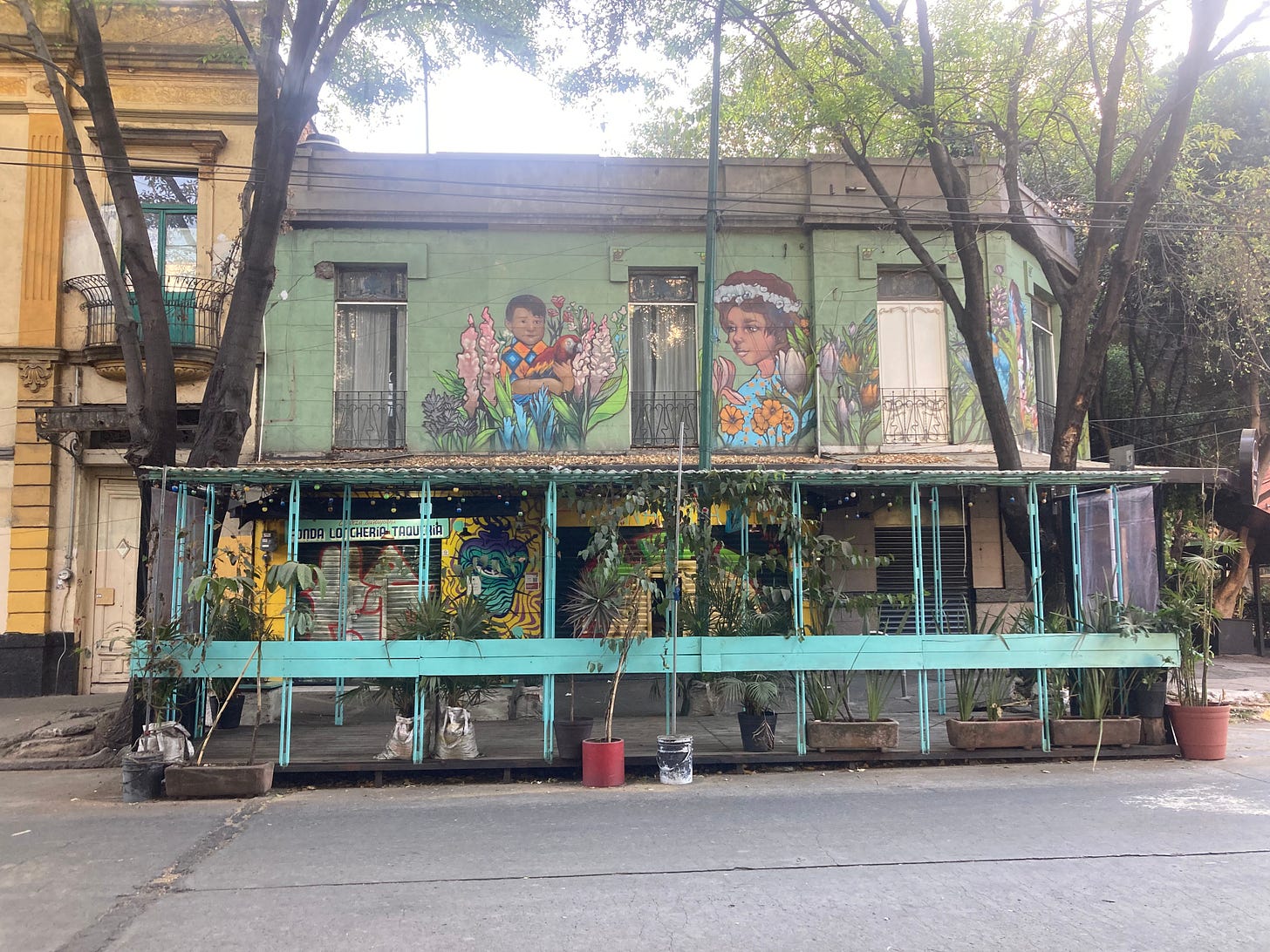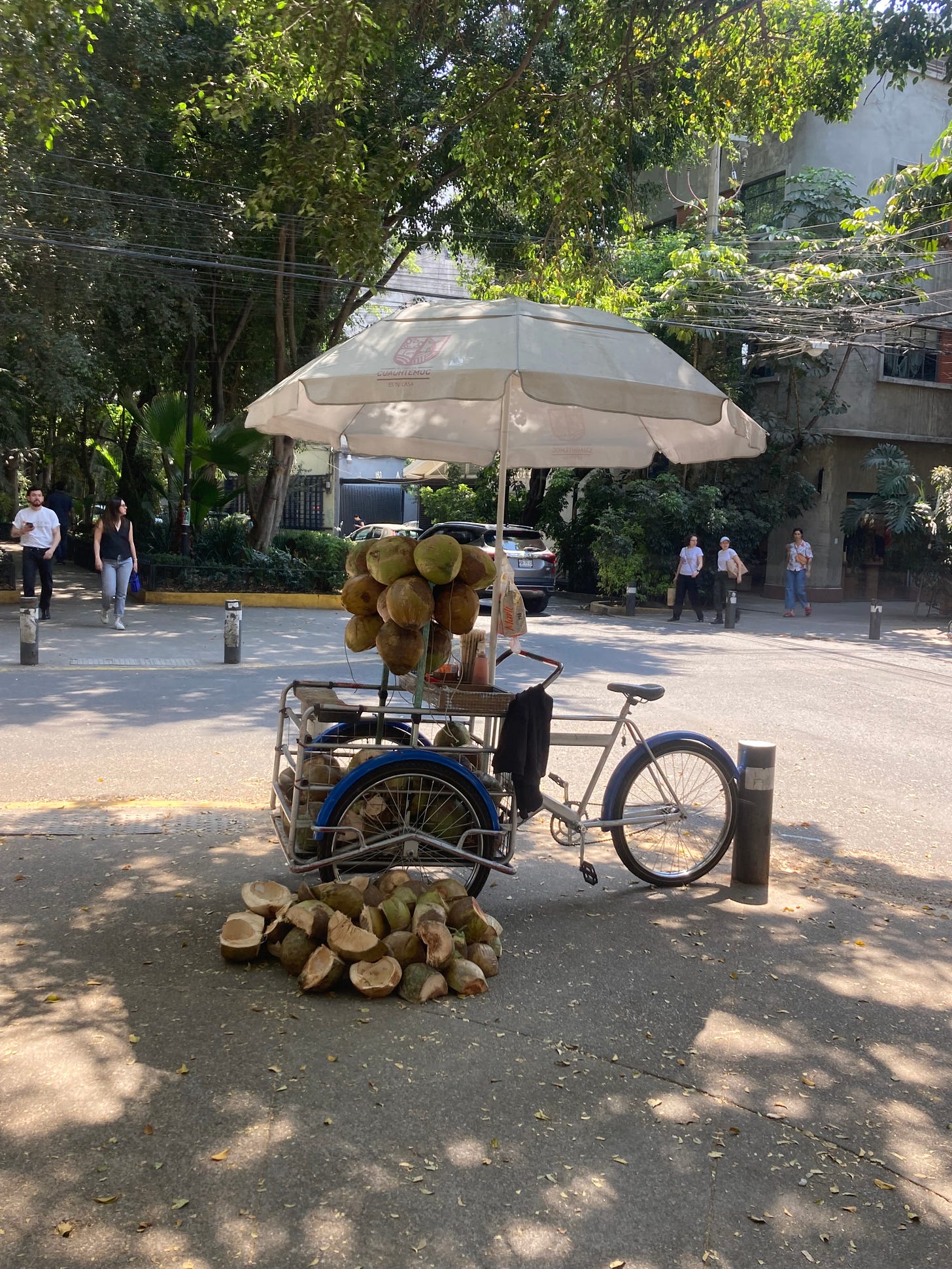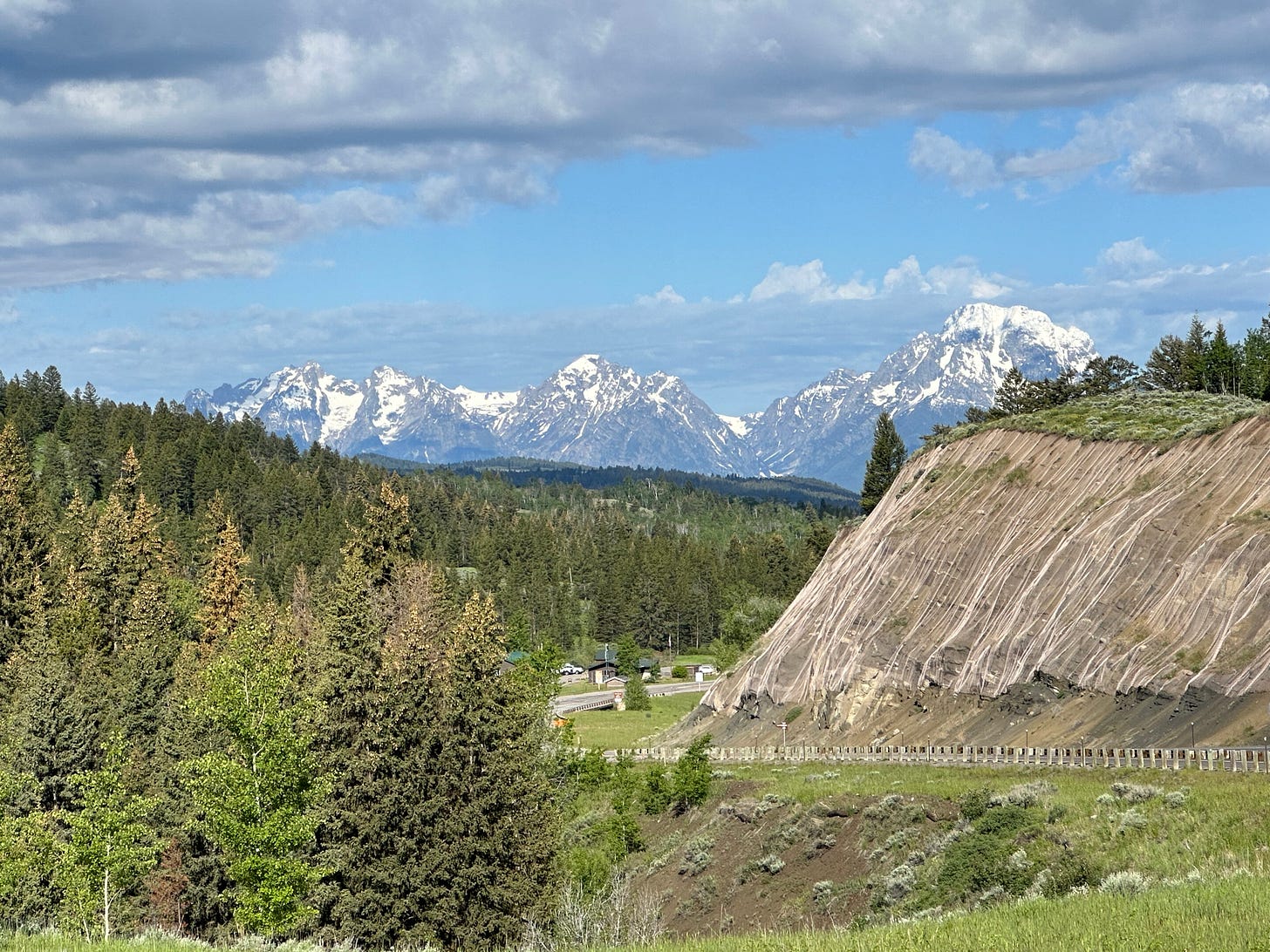Cuernavaca - Mexico City
A Sunday Ride
Our experience with Cuernavaca did not do it justice. We spent just two days in that City after expending an inordinate amount of energy to reach our “miraculous” destination. A vision of what to expect exceeded the reality. Perhaps additional prior research would have helped, perhaps not. Uncertainty and second-guessing are each part of the self-contained, unassisted, bike-touring experience. It really is at times inevitable.
Cuernavaca, the capital of the State of Morelos, has several beautiful public gardens, many colleges, universities, and schools, a well-preserved colonial center, and a renowned art and history museum featuring the murals of Diego Rivera. It is otherwise known as the City of Eternal Spring. The difference in elevation between the southern part of the City (where we entered) relative to the northern section where we stayed, about 1200 feet, provides for wide variety in terms of flora.
For the most part, however, Cuernavaca is known for its year-round temperate climate and as a haven for thousands of Mexico City residents looking for a cool and relaxing weekend in the forested mountain areas around the City, particularly Tepoztlán to the west. These are some of the reasons why we wanted to visit in the first place.
The difficulties we encountered reaching Cuernavaca sapped some of our enthusiasm and energy. We felt a strong desire to get moving in order to have more time in CDMX, of which we had heard many good things. We were also disinclined to pedal uphill further into the City, or downhill and then back up. Succumbing to the vicissitudes of bike touring, we acknowledged the correctness of our Mexican bike friends in Puebla, and pledged to ourselves to return to Cuernavaca one day in a better frame of mind. It just didn’t work out.
Bonding With a Local Bike Shop
Pam’s sad tire and rough bottom bracket were, in any event, getting most of our attention. We located what appeared to be a solid bike shop nearby and rolled over on a Saturday morning. The shop was a beehive of local biking activity with mostly young, skinny, team riders going in and out, drinking coffee (there was a small cafe there as well) and discussing in an animated manner the day’s ride, as well as upcoming races. The group of about 12 were sponsored by the shop and led by the shop’s owner, Roberto.
The group took an interest in our bikes, packs, kit, and plans. Several volunteered that they had plans to do some long distance touring. As was so often the case with the bike shops we visited in Mexico, they were able to get us (Pam’s bike) in right away for an examination. Pam’s tire was a wreck, and the bottom bracket worrisome.
After a very thorough diagnostic process, the young mechanic, wisely following the dictum of “do no harm,” determined there was really nothing he could do about the bottom bracket as they, nor anyone else in Cuernavaca, had the correct parts. As far as the tire was concerned, they did have one that would be suitable for the rim and would clear Pam’s fork. The width, however, did not match her other tire (by quite a bit). Roberto must have been on the phone for close to a 1/2 hour trying to find a correctly-sized tubeless-ready tire. He went so far as to call his distributor in Queretaro (200 miles away), to no avail. Roberto told us that it was likely no shop in Mexico had the tire width we were looking for. So, we went with the oddly-matched tire as it was better than the alternative, and posed no real problems as far as handling was concerned. That tire would last Pam until we reached Seattle several months later.
Since Roberto, and the other riders hanging out in the shop, knew the riding conditions in the area like the back of their hands, we asked many questions (mostly to Roberto, as he spoke good English) regarding our proposed route into Mexico City, as well as what it was like to run a bike shop in Mexico.
Considering a Rail Trail
Recall that one other major reason we wanted to go to Mexico City via Cuernavaca was to hop on one of the few long distance off-road rail trails to be found in Mexico. The trail, known as the Ciclopista Ferrocarril De Cuernavaca (around 60-65 miles in length)(technically a linear park), originates as a gravel/dirt/mountain route in Tepoztlán. The trail becomes paved in a small town (Tres Marias) about half-way to CDMX. The corridor then winds its way through fairly remote environmentally-protected areas and into CDMX, terminating in the center of the City.
The trail replaced a rail line that supported both freight and passenger service between Cuernavaca and CDMX. Rail service was available from around 1900 through the 1990s, and parts of the track within CDMX still support some freight traffic. Indeed, parts of the rail trail intersect with with freight lines, and we saw quite a few freight trains zip by.
We had read a few reports regarding the overall safety of the trail; several folks had been robbed in remote areas, although it seemed an unusual occurrence. We asked Roberto if he knew any details regarding riding the trail to CDMX. He and his friends had done it and felt that it was generally safe. However, he knew of a group of riders that had been recently robbed in the Tres Marias area (same area that we had read about). The robbers took his friends’ bikes and everything on them, leaving the group floundering in the middle of nowhere. The bikers eventually reached the nearby town’s police station and wanted to file a report. While waiting around for assistance, they noticed that the bikes were being hidden (not well) in a back room. The police report was obviously going to go nowhere.
Roberto hesitated, but then ultimately advised that we probably should not go unless it was with a local rider or two, and he was prepared to make some calls to provide us with a guide of sorts. His philosophy on the matter was that things would probably go OK, until they didn’t. He just did not have a great feeling about the trail.
This was quite disheartening for us as we really had wanted to ride the trail into CDMX. We recognized that he was probably being over-cautious, and did not want to see us hurt in any way. But, doubt had been planted into our brains and it was tough to disregard. We also did not want him to go to the trouble of asking other riders to come with us. The alternative was a tough road ride into the City. While not the most picturesque route, Roberto advised that the toll road was doable as there was a wide shoulder for most of the way and believed that we could do it as well.
A non-toll road became available in Tres Marias, but there was essentially no shoulder, so he advised against it. He did mention something about motorcycle clubs and heavy traffic on Sundays, but that bit of information did not really register with us at the time. We were too focused on just getting to CDMX.
We also discussed with Roberto his experiences running various businesses in Cuernavaca, including his current bike shop. He told us that it was not easy, and although business was decent, he was always on the alert for, and had to deal with, criminal activity, including extortion - i.e., having to pay to the local cartel protection money in order to permit the business to operate safely. Unfortunately, he had felt compelled to comply on several occasions. He also intimated that the local police were a joke.
Roberto essentially felt helpless, hopeless, and angry about the direction Mexico was headed relative to rule of law (or the absence thereof). He was hoping his 17 year-old daughter (who arrived at the shop while we were there) would go to college in the US or Europe (perhaps San Diego) in order to escape the whole scene. He told us that he and his wife never took their eyes off of their daughter and would not let her go anywhere alone for fear of kidnapping. While not an everyday occurrence, it apparently happens, below the radar, with some regularity.
Roberto, now in his early 50s, brought balance and some equanimity into his life through biking all over the Cuernavaca area and being involved as a sponsor of a bike team. We subsequently followed his biking adventures on the bike-oriented ride-sharing app Strava. He really is quite a biking maniac, impressively logging big miles in and around the hills of Cuernavaca on a consistent basis.
We left the shop with a mix of emotions. We were grateful for the time and energy Roberto and his crew spent working on Pam’s bike, as well as for the biking and safety advice. Our plan was to head for CDMX the next day,
Easy Riders
As a general rule, we get along really well with motorcycles and motorcyclists. We often wave to each other and exchange knowing looks. They have two wheels, we have two wheels. We also share with them a fear of cars and the careless drivers of those cars.
But on Sundays, motorcyclists on the Cuernavaca - CDMX toll highway come out in droves and exert two-wheel motor dominance over cars and the occasional bicyclist, letting their engines really unwind and pushing themselves to the limit, weaving in and out of traffic at high speed, despite the very obvious risks.
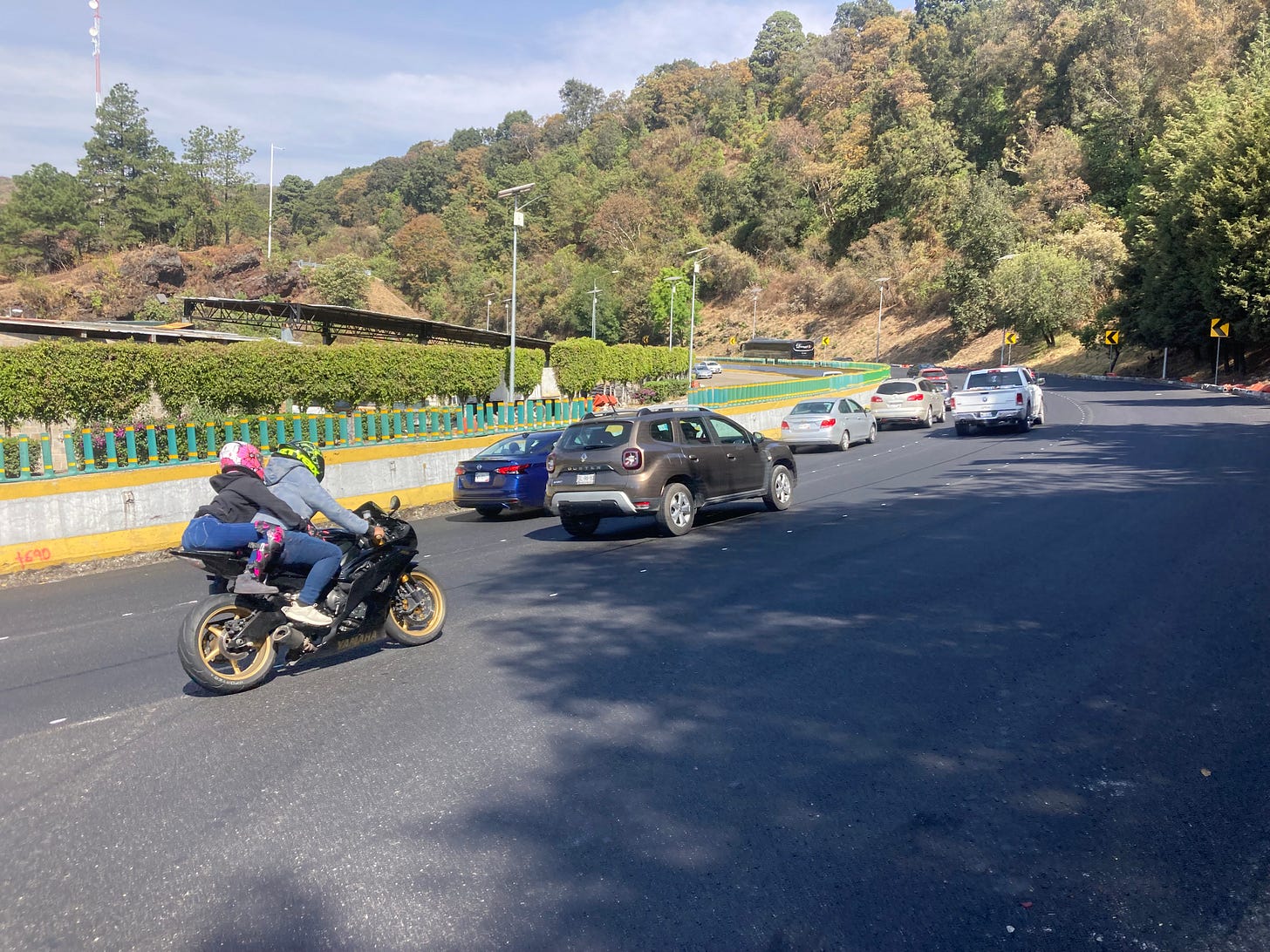
It was really an astonishing scene; we were to later learn in more detail that large motorcycle clubs in CDMX, Cuernavaca, and all over Morelos, use (take over) the Cuernavaca - CDMX toll road every Sunday and use it as a race track of sorts (without any police intervention whatsoever) due to its very good condition and local proximity. It would not have seemed so out of the the ordinary had there not been an enormous amount of car traffic carrying families back to CDMX after a weekend in the mountains. Truck traffic was also heavy. Traffic would often come to a standstill, causing difficult braking situations for the motorcycles traveling at astoundingly high speeds. We could hear the whine of the engine(s) (they seemed to travel in pairs) slowly getting louder from 1/2 mile away and would brace for peak volume. Invariably, each motorcycle was driven by a young male, with a young female hanging on for dear life on the back.
Unfortunately, motorcycle deaths are rampant in Mexico (13% of the total number of crash deaths in road accidents in Mexico are motorcyclists, mostly male and between the ages of 25-29) and this toll road has been ground zero for many of those fatalities. Just 18 months previously, 7 motorcyclists were killed and 15 injured during the course of 4 separate accidents occurring one after the other in very quick succession, due primarily to extremely high speed (reportedly 125 - plus mph). A local newspaper noted that “13 motorcycles, two tractor-trailers, a pick-up truck and at least twelve other vehicles were involved in the crashes which closed the [toll] highway for five hours.”
Due no doubt to the consistently high number of serious accidents, an ambulance station happens to be located, quite visibly, right on the highway a few miles outside of Cuernavaca. The station, of course, also sold snacks and drinks so we took a break and pounded down some gatorade.
We hugged the far side of the shoulder, kept our heads down, and just pedaled. The road out of Cuernavaca was, indeed, in very good shape, and views were often panoramic. Cuernavaca is set geographically into a bowl of sorts, and climbing out of that bowl was a slow process, finally peaking at about 10,000 feet.
It was not a uniformly terrifying experience. During one massive traffic slow down where not even our bikes could easily move forward, a young male motorcyclist came beside us with his girlfriend hugging him tightly from behind. He was extremely friendly, and spoke a little English. He was very interested in our biking activities around Mexico, wondered how we had ended up on this highway, and provided us with a detailed overview of, along with directions to, the best budget hotels just outside CDMX, all while motors are revving all around. He also informed us that he and his gal were soon heading for the western US on his motorcycle for a three month cycle tour and was interested if we knew anything about the California-Nevada-Utah area. We didn’t. After exchanging phone numbers, he rocketed ahead with his right hand in the air waving good-bye. The mayhem on the road did not come up in conversation.
Tres Marias
We took a short break upon reaching Tres Marias, poking around in a half-hearted effort to find the bike path, as well as to check out the non-toll, or libre, road. One had to proceed through a manned gate in order to enter the town.
I’m sure we looked somewhat like the proverbial deer staring into headlights, slowly biking around the very small, very poor, oddly-vibed town that existed tightly adhered to the busy toll highway. No one knew what we were talking about when it came to the bike path, but we were soon directed to the libre road. One look told us that we were better off on the toll highway as the libre had no shoulder and was chock full of high speed traffic. We therefore reluctantly returned to the motorcycle races and finished our ride into CDMX.
Approaching CDMX
The approach to CDMX turned out to be both exhilarating and frightening. It was wonderful to finally reach one of the biggest (population 21 million people) and greatest cities in the world. As a bonus, it was also a mostly downhill ride from Tres Marias.
The outskirts of CDMX were crowded with rows upon rows of tightly-packed shantytowns hugging the roadway, stretching for miles. I had previously read, and it turned out to be accurate, that the outskirts of Mexico City were not all that different in character from the favelas found in Rio de Janiero or Sao Paolo, Brazil. I later learned that fully 15-20% of the City’s total population lives in these areas (both north and south of the City). It was not a pretty sight.
Distressingly, as we approached our jump-off point into the City, we lost our riding shoulder, forcing us, at times, into the highway proper. The condition of the toll highway itself started to deteriorate as well, which was not surprising given the immense traffic volume obviously flowing every single day.
Arrival
Pam did what I would consider some heroic navigation and somehow got us off the damn highway in one piece and into a suburb of CDMX, Tlalpan. Tlalpan was a good choice. A distinct southern borough within CDMX, not often visited by tourists, it is home to a large university and a very attractive colonial-style downtown area that included more than a few coffee shops and small food trucks.
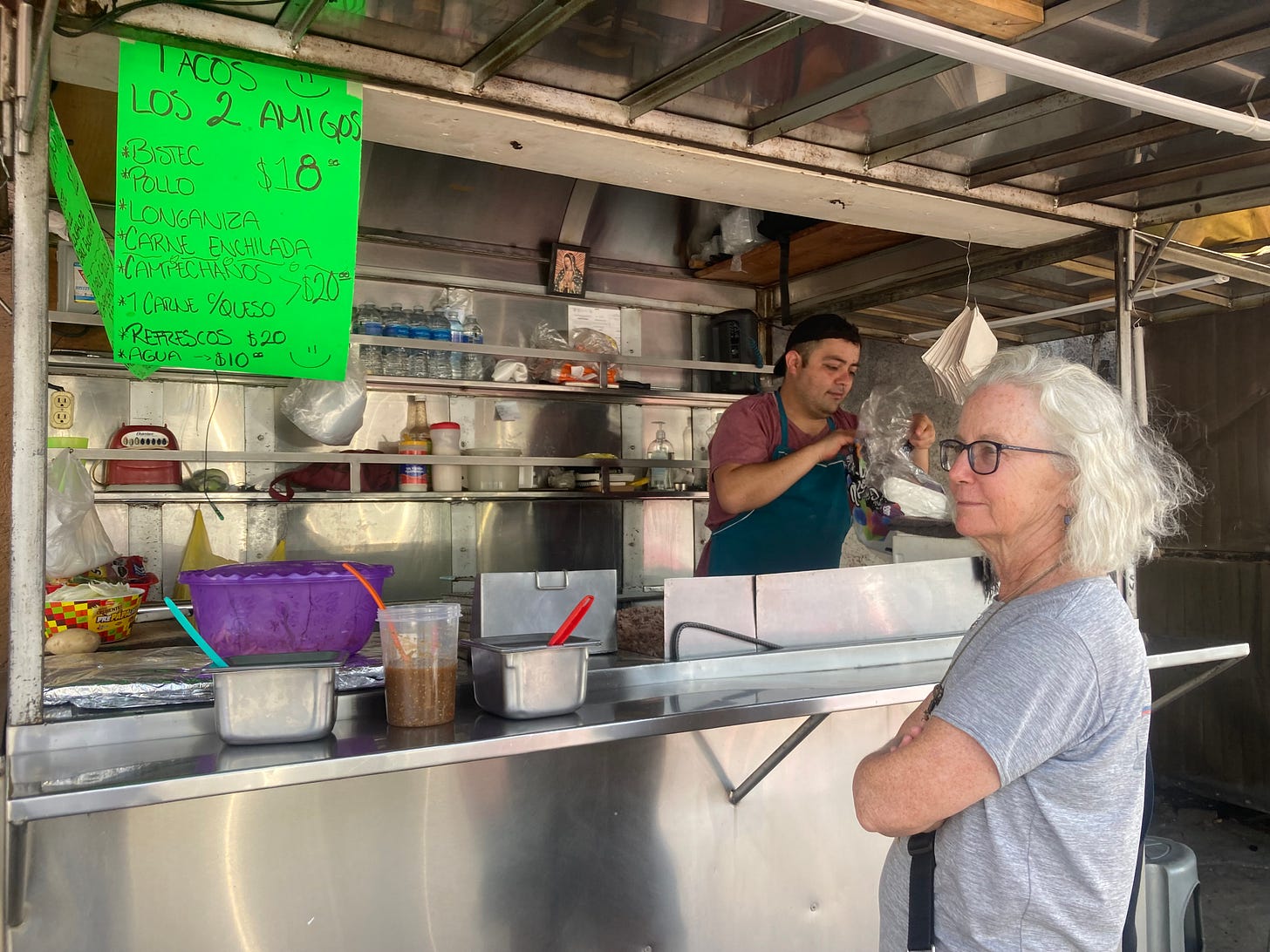
A little depleted from the ride into CDMX, we lingered a few days in Tlalpan before setting out for central Mexico City. Overall assessment of the day? In hindsight, the bus would have been a good option.
Next Time: Navigating and Cycling Around Mexico City
Real Time Update: We finished our US Northwest bike trip in Denver (Seattle - Denver), and are now back in New England contemplating our next trip this coming winter.





